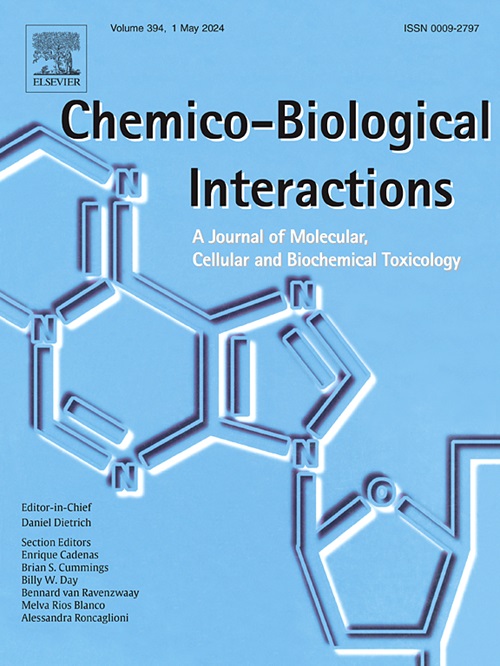手稿已提交:Chemico-Biological Interactions CHEMBIOINT-D-24-02395-R3 早期长期暴露于黄曲霉毒素 B1 会诱导衰老并改变草履虫与 SKN-1/Nrf2 相关的先天免疫。
IF 4.7
2区 医学
Q1 BIOCHEMISTRY & MOLECULAR BIOLOGY
引用次数: 0
摘要
黄曲霉毒素 B1(AFB1)是一种已知的人类致癌物质,是毒性最强的黄曲霉毒素代谢物。暴露于 AFB1 会导致氧化应激和免疫毒性增加,这是导致衰老的重要因素。然而,AFB1 引起的毒性在先天免疫力改变和衰老中的作用在很大程度上仍不清楚。线虫是研究衰老和毒理学的合适模式生物,因为它的分子机制研究得很清楚,而且生命周期很短。我们研究了 1、2.5 和 5 μM(312、781 和 1561 μg/L)浓度的 AFB1 对线虫生长、繁殖和寿命的影响。通过铜绿假单胞菌 PA14 缓杀试验研究先天性免疫,然后利用转基因菌株和 qPCR 分析研究可能的机制。结果表明,早期长期暴露于 AFB1(2.5 和 5 μM)会延迟秀丽隐杆线虫的发育、降低其繁殖能力并缩短其寿命。此外,在老龄蠕虫中,暴露于 AFB1 会导致秀丽隐杆线虫对铜绿假单胞菌 PA14 感染的存活率呈剂量依赖性下降。与成虫第 0 天相比,在有活大肠杆菌 OP50 存在的成虫第 4 天,AFB1(2.5 μM)会显著增加脂褐素水平(衰老的标志),而在用死大肠杆菌 OP50 喂养的线虫(成虫第 4 天)中则未观察到脂褐素增加。此外,用活的或死的大肠杆菌 OP50 喂养 skn-1 突变体时,脂褐素的增加也会消失。此外,AFB1抑制了肠道SKN-1::GFP的转位。双向方差分析显示,大肠杆菌 OP50 和 AFB1 的活性会交互影响 skn-1、gst-4、hsp-16.1、hsp-16.49 和 hsp-70 等基因的表达。我们的研究结果突显了 AFB1 诱导的毒性通过转录因子 SKN-1/Nrf2 的参与在改变先天免疫和衰老中的作用。本文章由计算机程序翻译,如有差异,请以英文原文为准。

Early life long-term exposure to aflatoxin B1 induces aging and alters innate immunity associated with SKN-1/Nrf2 in Caenorhabditis elegans
Aflatoxin B1 (AFB1), a known human carcinogen, represents the most toxic aflatoxin metabolite. Exposure to AFB1 causes increased oxidative stress and immunotoxicity, which are important factors contributing to aging. However, the role of AFB1-induced toxicity in altered innate immunity and aging remains largely unclear. The nematode Caenorhabditis elegans is a suitable model organism for studying aging and toxicology due to its well-studied molecular mechanisms and short life cycle. Effects of AFB1 at 1, 2.5, and 5 μM (312, 781, and 1561 μg/L) on growth, reproduction, and lifespan were examined. The Pseudomonas aeruginosa PA14 slow-killing assay was performed to investigate innate immunity, followed by studying the possible mechanisms using transgenic strains and qPCR analysis. The results showed that early life long-term AFB1 exposure (2.5 and 5 μM) delayed development, reduced reproduction, and shortened lifespan in C. elegans. Furthermore, in aged worms, AFB1 exposure caused a dose-dependent decrease in survival of C. elegans against P. aeruginosa PA14 infection. At adulthood day 4 in the presence of live Escherichia coli OP50, AFB1 (2.5 μM) significantly increased lipofuscin levels (a hallmark of aging) compared to adult day 0, whereas no increase in lipofuscin was observed in nematodes (adulthood day 4) fed with dead E. coli OP50. Additionally, the increased lipofuscin was abolished in the skn-1 mutant with either live or dead E. coli OP50. Furthermore, AFB1 suppressed intestinal SKN-1::GFP translocation. Two-way ANOVA analysis revealed that the activity of E. coli OP50 and AFB1 interactively affected the expression of genes: skn-1, gst-4, hsp-16.1, hsp-16.49, and hsp-70. Our findings highlight the role of AFB1-induced toxicity in altered innate immunity and aging through the involvement of the transcription factor SKN-1/Nrf2.
求助全文
通过发布文献求助,成功后即可免费获取论文全文。
去求助
来源期刊
CiteScore
7.70
自引率
3.90%
发文量
410
审稿时长
36 days
期刊介绍:
Chemico-Biological Interactions publishes research reports and review articles that examine the molecular, cellular, and/or biochemical basis of toxicologically relevant outcomes. Special emphasis is placed on toxicological mechanisms associated with interactions between chemicals and biological systems. Outcomes may include all traditional endpoints caused by synthetic or naturally occurring chemicals, both in vivo and in vitro. Endpoints of interest include, but are not limited to carcinogenesis, mutagenesis, respiratory toxicology, neurotoxicology, reproductive and developmental toxicology, and immunotoxicology.

 求助内容:
求助内容: 应助结果提醒方式:
应助结果提醒方式:


